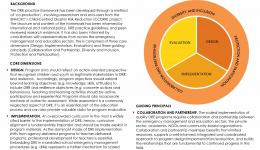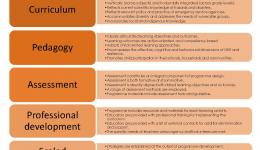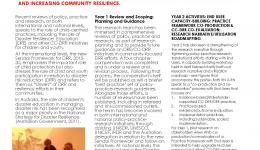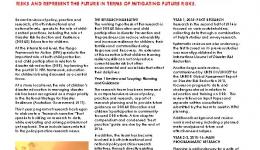Susan Dave is the Manager Community Connections at the Victorian State Emergency Service. Susan began her career as a Registered Nurse and moved into emergency management working for the Victorian Government. She previously worked as the Senior Policy Advisor at Save the Children Australia, working on policy and advocacy for the inclusion of the unique needs of children in all emergency management plans along with operational response when Save the Children respond to children’s needs in disasters. Susan is currently a PhD candidate at Monash University.
Lead end user
Children represent the most vulnerable demographic group in disasters – across the globe it is estimated that 30-50% of fatalities are children - while they are also most vulnerable to psychosocial impacts. Early research indicates that children are a resource for reducing current disaster risks and can also mitigate future risks.
The role of children’s disaster education in managing risk has been recognised as a major priority in the federal government’s National Strategy for Disaster Resilience. Yet, despite a recent surge in child-centred disaster research, the social, psychological, economic and political mechanisms that enable children to both understand and take action to reduce disaster risk remain largely unexplored and the evidence-base for best-practice remains limited.
This project is conducting a nationwide evaluation of programs and strategies based on a child-centred disaster risk reduction framework. It will develop cost-effective programs that reduce the risk and increase resilience for children, schools, households and communities.
The increasing frequency and complexity of natural hazards poses a challenge for community resilience. Communication and education of risk mitigation strategies play an essential role in building and maintaining resilience through preparation and planning by residents.
This project combined expertise in communication, social and consumer psychology, and disaster and emergency management. It identified barriers and enablers in residents’ decision making, preparing, and planning by examining residents’ intended use of different types of triggers for action during hazards. This included when to start evacuating and what information source to use, with the aim of trying to understand why some residents form a better-quality household plan with safer intended triggers than other residents.
Research team
| Type | Project | Research team |
|---|---|---|
| CRC Core Project | Child-centred disaster risk reduction | khaynes, kronan, sdavie, mpetal, nireland, jhandmer, djohnston, Annette Gough, Belinda Davis, ealisic |
Resources credited
| Type | Released | Title | Download | Key Topics |
|---|---|---|---|---|
| HazardNoteEdition | 21 Oct 2015 | Turning warnings into action |
|
communication, tsunami, warnings |








